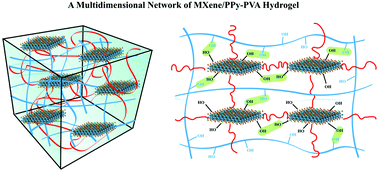A multidimensional nanostructural design towards electrochemically stable and mechanically strong hydrogel electrodes†
Abstract
Electrically conductive hydrogels are polymeric composites that combine electroactive fillers with hydrogel networks. They offer an electrically conductive pathway for electron transfer and provide an interconnected framework for ion diffusion, as well as an extended active interface for redox reactions, being ideal frameworks to design and construct flexible electrodes. In this work, we integrate nanoscale building blocks into a unique ternary (1, 2 and 3 dimensional) hydrogel architecture, where conductive polymer polypyrrole (PPy) nanofibers (1D) and MXene nanosheets (2D) are uniformly dispersed in polyvinyl alcohol (PVA) matrixes (3D). 1D nanofibers and 2D nanosheets were found to greatly increase the mechanical properties of the hydrogel hosts, demonstrating a remarkable tensile strength of 10.3 MPa and a large elongation over 380%. Moreover, the as-fabricated hierarchical structure effectively promotes electrolyte diffusion, exhibiting exceptional capacitive characteristics, including a high gravimetric specific capacitance of 614 F g−1 (at 1 A g−1) and an unprecedented cycling stability (100% capacitance retention over 10 000 cycles). A solid-state supercapacitor is assembled based on these MXene/PPy-PVA hydrogels, which demonstrates an efficient approach to the fabrication of wearable energy storage devices.



 Please wait while we load your content...
Please wait while we load your content...